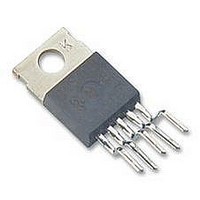LM2591HVT-3.3 National Semiconductor, LM2591HVT-3.3 Datasheet - Page 13

LM2591HVT-3.3
Manufacturer Part Number
LM2591HVT-3.3
Description
Voltage Regulator IC
Manufacturer
National Semiconductor
Specifications of LM2591HVT-3.3
Output Voltage
3.3VDC
Output Current
1A
No. Of Pins
5
Termination Type
Through Hole
Mounting Type
Through Hole
Peak Reflow Compatible (260 C)
No
Supply Voltage Max
60V
Leaded Process Compatible
No
Lead Free Status / RoHS Status
Contains lead / RoHS non-compliant
Application Information
INDUCTOR SELECTION PROCEDURE
Application Note AN-1197 titled "Selecting Inductors for Buck
Converters" provides detailed information on this topic. For a
quick-start the designer may refer to the nomographs pro-
vided in Figure 2 to Figure 4. To widen the choice of the
Designer to a more general selection of available inductors,
the nomographs provide the required inductance and also
the energy in the core expressed in microjoules (µJ), as an
alternative to just prescribing custom parts. The following
points need to be highlighted:
1. The Energy values shown on the nomographs apply to
2. The Energy under steady operation is
3. The Energy under overload is
4. The nomographs were generated by allowing a greater
steady operation at the corresponding x-coordinate
(rated maximum load current). However under start-up,
without soft-start, or a short-circuit on the output, the
current in the inductor will momentarily/repetitively hit
the current limit I
could be much higher than the rated load, I
represents an overload situation, and can cause the
Inductor to saturate (if it has been designed only to
handle the energy of steady operation). However most
types of core structures used for such applications have
a large inherent air gap (for example powdered iron
types or ferrite rod inductors), and so the inductance
does not fall off too sharply under an overload. The
device is usually able to protect itself by not allowing the
current to ever exceed I
to the regulator is over 40V, the current can slew up so
fast under core saturation, that the device may not be
able to act fast enough to restrict the current. The cur-
rent can then rise without limit till destruction of the
device takes place. Therefore to ensure reliability, it is
recommended, that if the DC Input Voltage exceeds
40V, the inductor must ALWAYS be sized to handle an
instantaneous current equal to I
irrespective of the type of core structure/material.
where L is in µH and I
current waveform with the regulator delivering I
These are the energy values shown in the nomographs.
See Example 1 below.
If V
e
case I
depends on the Inductance. See Example 2 below.
amount of percentage current ripple in the Inductor as
the maximum rated load decreases (see Figure 5). This
was done to permit the use of smaller inductors at light
loads. Figure 5 however shows only the ’median’ value
of the current ripple. In reality there may be a great
spread around this because the nomographs approxi-
mate the exact calculated inductance to standard avail-
able values. It is a good idea to refer to AN-1197 for
detailed calculations if a certain maximum inductor cur-
rent ripple is required for various possible reasons. Also
CLIM
IN
CLIM
instead of the steady energy values. The worst
>
40V, the inductor should be sized to handle
for the LM2591HV is 3A. The Energy rating
CLIM
PEAK
of the device, and this current
CLIM
. But if the DC input voltage
is the peak of the inductor
CLIM
without saturating,
LOAD
. This
LOAD
.
13
5. Figure 4 shows the inductor selection curves for the
Example 1: (V
5V
1. A first pass inductor selection is based upon Inductance
and rated max load current. We choose an inductor with the
Inductance value indicated by the nomograph (Figure 3) and
a current rating equal to the maximum load current. We
therefore quick-select a 100µH/0.8A inductor (designed for
150 kHz operation) for this application.
2. We should confirm that it is rated to handle 50 µJ (see
Figure 3) by either estimating the peak current or by a
detailed calculation as shown in AN-1197, and also that the
losses are acceptable.
Example 2: (V
5V
1. A first pass inductor selection is based upon Inductance
and the switch currrent limit. We choose an inductor with the
Inductance value indicated by the nomograph (Figure 3) and
a current rating equal to I
100µH/3A inductor (designed for 150 kHz operation) for this
application.
2. We should confirm that it is rated to handle e
procedure shown in AN-1197 and that the losses are accept-
able. Here e
Example 3: (V
10V
1. Since input voltage is less than 40V, a first pass inductor
selection is based upon Inductance and rated max load
current. We choose an inductor with the Inductance value
indicated by the nomograph Figure 4 and a current rating
equal to the maximum load. But we first need to calculate Et
for the given application. The Duty cycle is
where V
Schottky) and V
And the switch ON time is
where f is the switching frequency in Hz. So
@
@
consider the rather wide tolerance on the nominal induc-
tance of commercial inductors.
Adjustable version. The y-axis is ’Et’, in Vµsecs. It is the
applied volts across the inductor during the ON time of
the switch (V
which the switch is on in µsecs. See Example 3 below.
@
0.8A
1A
1A
D
is the drop across the Catch Diode () 0.5V for a
CLIM
IN
IN
IN
SAT
≤ 40V) LM2591HV-ADJ, V
is:
≤ 40V) LM2591HV-5.0, V
>
IN
-V
40V) LM2591HV-5.0, V
the drop across the switch ()1.5V). So
SAT
-V
CLIM
OUT
. We therefore quick-select a
) multiplied by the time for
IN
IN
IN
= 24V, Output
= 48V, Output
= 20V, Output
www.national.com
CLIM
by the










